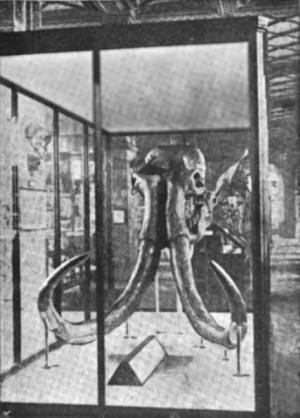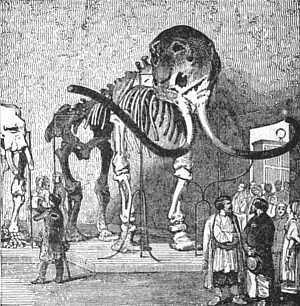Skeleton of a Mammoth Found Near London - 1824
from Gentleman's Magazine (May 1824)

The entire skeleton of a large Mammoth, i.e. a fossil elephant of the same species with those which occur in Siberia, and all over Europe, has been very recently discovered near London, at Ilford, in the county of Essex, near Stratford and Bow. It lay buried at the depth of about sixteen feet, in a large quarry of diluvian loom and clay which is excavating for making bricks. Mr. John Gibson, of Stratford, has been diligently exerting himself in collecting and preserving as much as possible of this skeleton; and a few days since he invited Professor Buckland and Mr. Cliff to assist him in disinterring the remainder of the bones which he had purposely left in their natural position in the quarry. These gentlemen found a large tusk and several of the largest cylindrical bones of the legs, also many ribs and vertebrae, with the smallest bones of the feet and tail lying close upon one another, so that there can be no doubt, that with those before collected by Mr. Gibson, they had made up an entire skeleton, at least fifteen feet high; they were imbedded in tenacious clay (which is dug for bricks) being part of the great superficial covering of diluvian clay, sand, and gravel, which is spread over a large portion of the counties of Essex, Suffolk, and Norfolk, and along the whole east coast of England, at irregular intervals, and is almost every where occasionally discovered to contain remains of antediluvian animals similar to those at Ilford, viz. the tusks, teeth, horns, and bones of the elephant, rhinoceros, horse, and stag, &c. &c. Many other tusks and bones have, within these few years, been discovered and preserved by Mr. Thompson, the proprietor of the Ilford Clay Pits, some of which he has presented to the Royal College of Surgeons, whilst others are still in his own possession. Two enormous tusks, also, and a large thigh bone of an elephant, from the same place, have been presented by J. W. Russell, Esq. to the Geological Society. These bones at Ilford, when first uncovered, are usually entire and perfect in their form, but are so extremely tender whilst wet, that it is almost impossible to extract them unbroken. On being dried, however, they acquire a considerable degree of firmness. It is much to be regretted that, although Mr. Gibson has preserved fragments of almost every limb of the elephant in question, they are so much broken that it is impossible for the skeleton to be restored and mounted, as has been done in the case of the elephant of the same species, which was found, with even his flesh and hair perfectly preserved, in a cliff of ice on the shore of Fungusia, and which is now standing, with the dried flesh still adhering to the head, in the Imperial Museum at St. Petersburg.
Mammoth Skull and Tusks Found at Ilford - 1864
from The Strand Magazine (1896)
[p.68] No one would think of seeking for romance amid the pre-historic skeletons that haunt the long gallery at the Natural History Museum, which is under the supervision of Dr. Woodward. And yet romance is certainly there. First of all let me show the skull and tusks of a mammoth—a particularly prominent feature of the gallery before mentioned. Now let me tell the story: As long ago as 1844, Sir Antonio Brady, an enthusiastic geologist and scientist, had his attention drawn to the great deposits of brick earth occupying the valley of the River Roding at Ilford, near his [p.69] own residence. Some idea may be formed of the pal�ontological wealth of this deposit when I mention that Sir Antonio Brady obtained from it in this one locality over a thousand specimens of mammalian remains. One of the first of this gentleman's finds was made while workmen were digging clay for the manufacture of bricks for the Great Eastern Railway, then in course of construction. The owner of the field, a Mr. Thomas Curtis, invited quite a crowd of scientific gentlemen down to Ilford to view the bones that had turned up. All these were exhumed with much care, some of them being deposited subsequently in the Museum at the Royal College of Surgeons.

When notice of a fossil “find” was brought to Sir Antonio Brady, he would first of all reward the finder, and in many cases paid large sums in order that a whole gang of labourers might remain idle while the precious bones or tusks were being carefully removed from the earth. These same bones and tusks, by the way, were, as a rule, very fragile, and had to be immediately treated with liquid glue, wet paper, and plaster of Paris. As a matter of fact, this enthusiastic scientist would deal as tenderly with fossil remains as though he were an expert surgeon handling broken human limbs.
One day in 1864, a messenger was despatched in hot haste to Sir Antonio Brady with news of an important find in the Uphall brickfield, at Ilford, owned by a Mr. William Hill. On arriving. at the spot, Sir Antonio found that the workmen had come upon an immense skull and tusk about 15ft. below the surface of the earth. The cranium itself was nearly entire, the upper portion only of the left side having received a blow from a pick or a spade when the workmen first came upon it. It is probable that the entire skeleton was there, for, before news of it had got abroad, the workmen, knowing nothing of the Elephas primogenius, had broken up the bones they had come upon week after week and carried them off in bagfuls to an old bone shop, where they were promptly exchanged for coppers, which were of far more value to the finders than all the skeletons in the Natural History Museum.
When they came upon the tusks, however, the overseer interfered,
feeling sure that his men had come upon a big thing in more ways than
one. It was entirely owing to the skill and judgment of Sir Antonio
Brady and the experts from the Natural History Museum that this
mammoth's head was removed from the matrix entire, and brought away in
safety. The right tusk, together with a portion of its socket, had
evidently become detached, for [p.70]
it was found upon the same level
in the pit, but nearly 20ft. away from the cranium to which it
belonged. Of course, the whole specimen received prompt attention, and
it was thoroughly drenched with a solution of glue in hot water. One of
the tusks alone is estimated to have absorbed no less than three
gallons of this solution. The tusks measure 8ft. 8in. on the outside
curve, from the point to the insertion in the socket, the length held
within the socket being about 18in. The circumference of the tusk at
one foot from the socket is 26in. By the side of this important
specimen in the Natural History Museum are photographs of the entire
skeleton of the mammoth, as seen in the St. Petersburg Museum.
The latter skeleton, too, has a singularly interesting story. It was discovered by a Tungusian chief in the summer of 1799, half buried in the frozen soil and ice at the mouth of the River Lena in Siberia. When the gigantic beast was entirely freed from the ice, in 1804, the chief cut off its horns and exchanged them with a merchant for goods to the value of sixty roubles, or in English money, �7 18s. 4d.—the reward of five years' watching and waiting. Two years later Adams heard of the skeleton, and traced out the spot where it lay. He then sent the remains to St. Petersburg, a distance of 11,000 versts, or 7,330 miles. The missing tusks turned up later on, and the skeleton was built up in the St. Petersburg Museum.
The curious part of this story is that Professor Maskelyne, who
examined this mammoth skeleton very carefully when in St. Petersburg,
in 1865, gave his opinion that the tusks did not belong to the skull.
In any case, the authorities at the Natural History Museum state that
the tusks have been wrongly fixed [left]. The Russian authorities, on the
other hand, said that they are right and that our own scientists are
simply libelling the unfortunate mammoth in setting up its tusks as
seen in our picture [right].
 5 May - short
biography, births, deaths
and events on day of 1824 Ilford mammoth skeleton discovery.
5 May - short
biography, births, deaths
and events on day of 1824 Ilford mammoth skeleton discovery.




